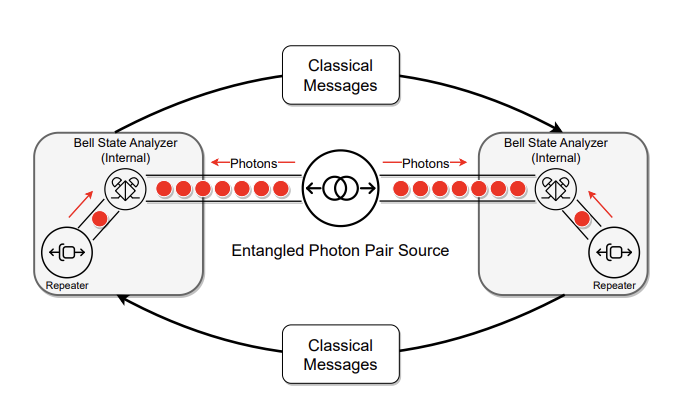A whole pile of our #QuantumInternet engineering papers hit the arXiv yesterday! I'll try to give just a short summary of each paper, so this post doesn't get insanely long. We are currently building a testbed quantum network, so a lot of this material addresses problems we are facing now or will in the very near future. We have three papers on use of entangled photon pair sources (EPPS nodes, in our lingo), a low-level engineering paper on getting the timing right, a paper on how to construct and use efficient switches, and a paper looking a little farther into the future at advanced techniques using complex, many-photon entangled states.
First up, a paper by Soon (all of these papers were highly collaborative in both research and writing, but I will identify each of them by the first author) on design and simulation of a particular link type, using entangled photon pair sources in the middle of the link as above. We call these MSM, or memory-source-memory, links. This kind of link was explored by Cody Jones back in the day, but not fully simulated (or implemented), which of course leaves holes in the needed protocol design and the possibility of dynamic effects that don't show up in an initial analysis. Interestingly, carefully throttling the entanglement attempt rate results in better throughput, a rather unexpected effect. We call the problem the mutual latch-fail phenomenon.
https://arxiv.org/abs/2405.09861
Soon followed that up immediately with a second paper on how longer, multi-hop paths behave when the links are different types. Reassuringly, paths where most of the links are one type but one is different seem to perform as well as completely homogeneous paths. This boosts our confidence that heterogeneous networks will work, and that introducing new technologies won't be a forklift/flag day upgrade.
https://arxiv.org/abs/2405.09862
Those first two apply pretty broadly to different types of network deployments: data center, LAN, WAN. In a third, related paper, Paolo Fittipaldi of Frédéric Grosshans' group simulated a particular subtype of MSM links: satellite! The figure above is probably too small to read here, so I recommend you actually read the paper. But with what we believe are realistic parameters, distribution of several entangled Bell pairs per second while the satellite is visible seems achievable. Performance is largely driven by the photon loss and latency (of course), but also (perhaps less obviously) by the amount of memory available at the ground stations. Extending this to examine the behavior of applications that use such a link, satellite-to-satellite connections, and networks that extra into metropolitan areas around the ground stations will make for interesting work.
https://arxiv.org/abs/2405.07589
Those first three make a pretty good set if you are interested in how entangled photon pair sources will behave in networks.
Since we are talking about preparing for heterogeneity, let me stick in a placeholder here for another paper that should appear momentarily. Poramet has done good work on how to combine purification and error correction in networks. Stay tuned for the paper.
Photons are most useful in our plans when they are entangled with something else (a memory or another photon), and come together in pairs so that we can measure them together, a technique known as entanglement swapping achieved via Bell state analysis or Bell state measurement. To accomplish this, we need good overlap of the arrival times of the photons, which we achieve by changing the length of the path that one photon follows. The basic idea is obvious, but it takes work to get the details right, and our team with Mori-san as first author worked them out. Rob Thew's gang is doing related work; see Secs. VII & VIII of a paper of theirs. We weren't aware of this particular paper before writing ours, but I think there is still value in the engineering analysis we present on tradeoffs in different possible configurations, both for single-hop and multi-hop paths.
https://arxiv.org/abs/2405.09881
https://arxiv.org/abs/2405.09860
Finally, the most technically obscure of the topics on the menu, Naphan's work on repeater graph states (RGSes). The challenge is that photons get lost, but the no cloning theorem and work related to quantum error correction tells us that we can't successfully reconstruct a quantum state if we lose more than half the photons. But with RGS, originally found by Azuma-san and with extensive work by the group of Sophia Economou, if you create a complex entangled state and can make quick decisions about the choice of what to do with the photons you do get, then you can handle losing certain subsets of photons. The theory is great, but implementing networks using these states isn't going to be easy, even aside from the physics problem of generating them correctly. Naphan has found ways to reduce the required classical communication by three (decimal) orders of magnitude. We continue to make progress toward practical implementation!
https://arxiv.org/abs/2405.09876
Whew! That's a ton of work, and we hope that it all helps bring closer the day when we can deploy quantum networks for production use, as a system interconnect for a multicomputer, in the data center, and in LANs, MANs, WANs and ultimately intercontinental quantum networks.
Oh, did I mention that the first authors of three of the above papers are undergraduates who just entered their third (junior) year? Bet you'll have trouble picking out which ones. Our students are amazing (both the undergrads and grad students).
Thanks for reading this long posting, and let us know if you have comments!






